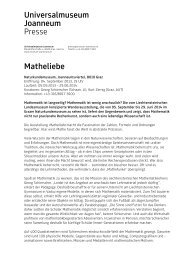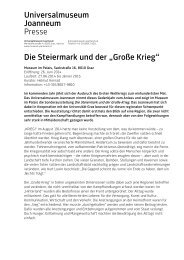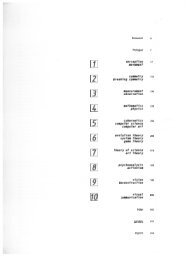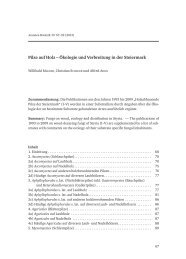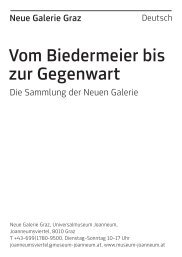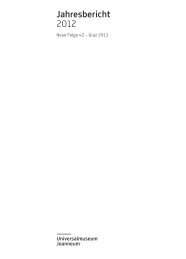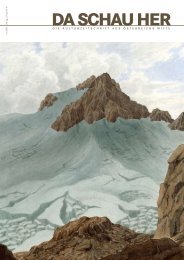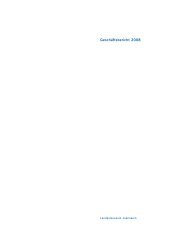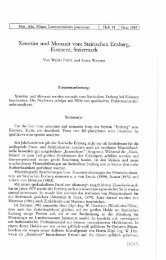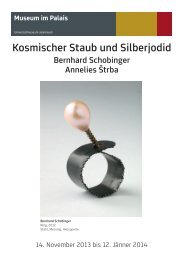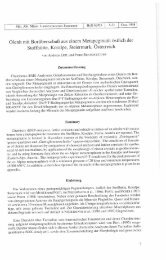Diana Thater gorillagorillagorilla - Universalmuseum Joanneum
Diana Thater gorillagorillagorilla - Universalmuseum Joanneum
Diana Thater gorillagorillagorilla - Universalmuseum Joanneum
Sie wollen auch ein ePaper? Erhöhen Sie die Reichweite Ihrer Titel.
YUMPU macht aus Druck-PDFs automatisch weboptimierte ePaper, die Google liebt.
zur visuellen Hauptschicht der Installation übernimmt und mit<br />
seiner textuellen Struktur und konzeptuellen Aufladung einen parallelen<br />
alternativen semantischen Zugang zu einer Bedeutungsvielfalt<br />
und zusätzlichen Wahrnehmungsmöglichkeiten bietet.<br />
Der Ursprung von <strong>Diana</strong> <strong>Thater</strong>s indexikalischen Experimenten<br />
ließe sich vielleicht auch in der Stilistik des strukturalistischen<br />
Filmemachens aufspüren. In Hollis Framptons stark von Borges<br />
und Pound beeinflusstem 16mm-Film Zorns Lemma (1970)<br />
werden mehrere intellektuelle Ordnungssysteme angewandt und<br />
als Strukturmodelle und Zeitmessungsmechanismen angeboten,<br />
wie zum Beispiel das Alphabet, ein Bildarchiv der Straßenbeschilderung,<br />
Rezitationen. P. Adams Sitney merkt dazu Folgendes an:<br />
„Unsere Wahrnehmung des Films ist unsere Mitwirkung an der<br />
Entdeckung seiner Ordnung.“21 Für <strong>Diana</strong> <strong>Thater</strong> ist Framptons<br />
Film „auch struktural insofern als er ein anderes Ordnungssystem<br />
als die Erzählung verwendet, um eine lesbare Sequenz zu<br />
erzeugen. Und obwohl man sich auf das Lesen konzentriert (…)<br />
wird Bedeutung erzeugt“22. Zorns Lemma – betitelt nach Zorns<br />
Lemma, einem Theorem der Mengenlehre, das der Mathematiker<br />
Max Zorn 1935 formuliert hat und gemäß dem „jede nichtleere<br />
halbgeordnete Menge eine total geordnete Teilmenge enthält“ –<br />
ist „eine Übung in mathematischer Logik im Film“, die darauf<br />
abzielt, die Verfahren der Wahrnehmung und der Generierung<br />
von Bedeutung über die Erzählstandards des Kinos hinaus<br />
auszudehnen. Ganz ähnlich wie <strong>Thater</strong>s Multi-Screen-Installation<br />
Knots + Surfaces (2001), die auf aktuellen Theorien in der<br />
Quantenmathematik basiert, war Zorns Lemma ganz stark von<br />
der Naturwissenschaft gespeist und beeinflusst, so wie auch<br />
andere Filme von Hollis Frampton ihre Titel spezialisierten Wissenschaftsdisziplinen<br />
entnehmen, wie der Physik (Surface Tension,<br />
1968) oder der Philologie (Palindrome, 1969) und auch ihre<br />
Strukturmodelle aus den akademischen Disziplinen ableiten.23<br />
II.<br />
Bewegung des Werdens<br />
„Die Sensation malen, die wesentlich Rhythmus ist (…)“– so<br />
beschreibt Gilles Deleuze das grundlegende Streben im Schaffen<br />
Francis Bacons.24 Der Autor von Francis Bacon – Logik der<br />
Sensation konzentriert sich auf Bacons Leidenschaft für Triptychen<br />
und weist ihnen einen privilegierten Platz im Gesamtwerk<br />
des Malers zu: „Dass das Triptychon traditionellerweise eine<br />
mobile oder Möbel-Malerei ist, dass die Seitenflügel des Triptychons<br />
oft Beobachtende, Betende oder Schutzheilige enthalten<br />
haben, all das kommt Bacon gelegen, der seine Gemälde als<br />
and, with its textual fabric and conceptual charge,<br />
constructs a parallel alternative semantic avenue for<br />
a multiplicity of meanings and additional perceptual<br />
possibilities.<br />
The origin of <strong>Thater</strong>’s indexical experiments might<br />
also be traced to the stylistics of structuralist filmmaking.<br />
In Hollis Frampton’s Borgesian and Poundian<br />
16 mm film Zorns Lemma (1970), there are several<br />
intellectual orders applied and provided as structural<br />
models and timing mechanisms, like, for instance, the<br />
alphabet, image archive of street signage, recitations.<br />
As Sitney observes, “Our perception of the film is a<br />
participation in the discovery of the ordering.”21 For<br />
<strong>Thater</strong>, Frampton’s film is “also structural in that it<br />
uses an ordering system other than narrative to make<br />
a readable sequence. And though one concentrates<br />
on reading (…) meaning is being made”22. Zorns<br />
Lemma – titled after Zorn’s lemma, a proposition of<br />
set theory, formulated by mathematician Max Zorn<br />
in 1935, according to which “every partially ordered<br />
set contains a maximal fully ordered subset” – is “an<br />
exercise in mathematical logic in cinema” which aims<br />
at expanding the perceptual and meaning production<br />
modes beyond cinematic narrative standards.<br />
In a similar way to <strong>Thater</strong>’s multi-screen installation<br />
Knots + Surfaces (2001), based upon recent theories<br />
in quantum math, Zorns Lemma has been heavily fed<br />
and influenced by science as other Frampton’s films<br />
that derive their titles from specialized disciplines,<br />
such as physics (Surface Tension, 1968) or philology<br />
(Palindrome, 1969) and take their structural models<br />
from the academic disciplines.23<br />
II.<br />
movement of becoming<br />
“Paint the sensation, which is essentially rhythm…”,<br />
that is how Gilles Deleuze identifies the basic desire<br />
of Francis Bacon’s oeuvre.24 The author of Francis<br />
Bacon. The Logic of Sensation concentrates on the<br />
painter’s passion for triptychs and assigns their privileged<br />
position in the artist’s entire oeuvre: “That the<br />
triptych was traditionally a mobile painting or piece of<br />
furniture, that the wings of the triptych often included<br />
observers, priors, or tutelaries – all of that suits Bacon,




